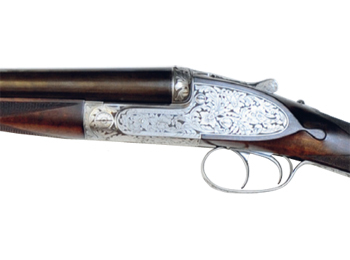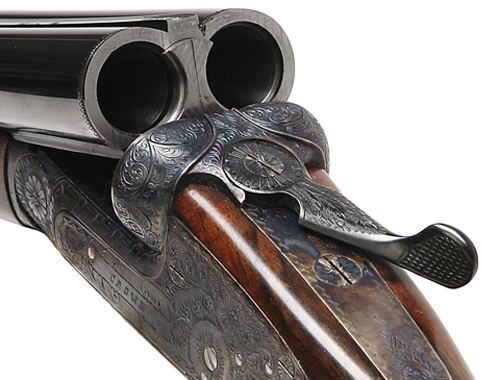16-bore shotguns under £10,000
In many ways 16-bores have been left to one side in the rush towards smaller bores and lighter guns seen in recent years. Evidently, 20 and 28-bore guns are among the most popular available at the moment and I have written guides on such guns in the past. But buyers are missing out on the pleasure of shooting a 16-bore.

16-bore shotguns under £10,000
A 16-bore gun offers the sportsman a lighter gun which still has a very good killing power and range, especially now there is a good selection of modern 16-bore cartridges available. Even for those guns who shoot the highest and most extreme birds, the 16-bore should be considered a genuine alternative.
I have just sold a pair of Purdey 16-bores with 30″ barrels, and talking to the gentleman who purchased them he was very impressed and surprised at how well they perform on high birds.
In the late 1970s my father managed to obtain a pair of 16-bore Purdeys which had been made in the 1930s with 28″ barrels. Although I may be looking back with rose-tinted spectacles, I think he shot some of the best birds I ever saw him shoot with them.
However, my father analysed his shooting in great detail and didn’t remember the birds he shot, only those he missed. It only needed one bad day and they were up for sale.
A popular calibre
The 16-bore was always very popular in Europe, with it being the preferred gauge in France and Germany.
They were also very popular in my area, the Lincolnshire fens, with a lot of local farmers using these guns in the 1950s and 1960s. The 20-bore was then looked on more as a lady’s gun and the 16-more of a man’s gun. There is a limited selection of over-under 16-bores, the most common being East German guns from Merkel.
The Italian makers never really got into the 16-bores, though in more recent years we have seen one or two guns from Lincoln and one or two Japanese Brownings appearing in 16-bore.
However, these guns tend to be rather heavier, whereas the Merkel was built more on a scaled down action and is a rather truer interpretation of the 16-bore.
Problem with 16-bores
The one problem I do see with 16-bores is the unfortunate situation of being caught out on the day, or worse on the peg, and running out of cartridges.
You will be very lucky to find another person in your team using a 16-bore to borrow cartridges from, so I would suggest you always take plenty with you when straying away from your favourite 12-bore.
This is good advice for any shoot day: it is good manners, and you will avoid insulting your host by ensuring you have enough cartridges to shoot at his birds.
Purdey sidelock 16-bore shotgun
I have already mentioned the pair of these which I sold recently.

They were in excellent order throughout and with the more unusual 30″ barrels had the weight biased very slightly forward of hinge pin. Chokes were quarter and half, which are the measurements I would recommend on a 16-bore if you are going to be shooting the more extreme birds. On good 40-yard partridges I would recommend improved cylinder and quarter.
The stocks on these guns were straight hand with a fairly dense best French walnut wood counteracting the weight of the longer tubes.
As such they were not over-hollowed, which can often be the case with best sidelocks. The actions on best London sidelocks can be very slender, and a lot have been re-barrelled down to 20-bore from their original 16-bore manufacture.
Personally I think this is a great shame, especially as 16-bore guns are becoming more popular again.
These particular guns had 2¾” chambered barrels, so would take the bigger, more punchy loads if need be, making it an ideal gun for high pheasants.
The price of something like a Purdey 16-bore does vary enormously. I would suggest if you are looking to purchase one in all original condition it would likely cost over £10,000.
Obviously later guns are a lot more, going into the £20,000 or even £30,000 region for a very late one.
W.J. Jeffrey boxlock 16-bore shotgun
As I have written in the past, a good boxlock offers fantastic value for money and a fine shooting experience.

We currently have a 16-bore W. J. Jeffrey boxlock ejector with 27″ barrels, built c.1920 when a lot of boxlock ejectors were being produced in Birmingham.
This is a London gun, but it is almost certain it started life in Birmingham.
The gun is a best square frame with Scott lever and Southgate ejectors as is used on nearly all modern guns today. There is a straight-hand stock, which at some point in its life was shortened and then lengthened again in best matching wood. The stock has been well hollowed to counteract the weight of the metal parts of the gun, keeping the balance nicely between the hands.
The action is beautifully scroll engraved throughout, retaining some of its original colour hardening.
An English boxlock will be a good, reliable gun to own and shoot with, but will also have all the character you would expect from a hand-made English shotgun.
Merkel 201E 16-bore shotgun
Over-under guns in 16-bore are very rare and difficult to find, so if you come across one I would recommend you snap it up.

When buying an older German gun you should be very wary. It is essential you ensure they are either English or Belgian proved. After WWII the German proof was not accepted, but a lot of guns found their way into the country via American and British servicemen returning from Germany.
The action of the Merkel is slightly deeper than you will see on a more modern over-under, and this enables it to have a full cocking dog and full body pin, with “V” spring main springs as on an English gun.
You must make sure the stock is sound, as the guns did not have a body bolt like modern over-unders, and the cheeks of the stock fitting into the action can sometimes be seen to be coming away from the metal.
Though you should approach a gun from this era with caution and check the gun thoroughly before purchase, you should not be put off.
These are good guns, very underrated and overlooked by the British shooter. They also represent remarkable value for money for a handmade over-under shotgun.
Gun reviews: William Powell Monarch 16-bore shotgun
Gun reviews: William Powell Monarch 16-bore shotgun: With its traditional looks and smooth handling, Lewis Potter discovers a gun that…
Arietta Crown 16-bore shotgun review
Gun reviews: Arietta Crown 16-bore shotgun: The Arietta Crown is a lovely little 16-bore from the renowned Spanish gunmaker.
Westley Richards 16-bore shotgun review
Westley Richards 16-bore shotgun: Sweet and fast to shoot, this lightweight side-by-side droplock is exceptionally well finished.
William & Son 16-bore shotgun review
William & Son 16-bore shotgun: The result of hours of work from some of the world’s most talented gunmakers, this…
Browning B25 16-bore shotgun review
Browning’s new B25 16-bore shotgun feels just right – but could also be a rifle, with other barrels.
Lincoln Jubilee 16-bore shotgun review
The Lincoln Jubilee Prestige shotgun celebrates the return of the 16-bore.
12 bore vs 16 bore – the great debate
Which would be your choice in the 12-bore vs 16 bore conversation? Ask some people why they use a 16-bore…















